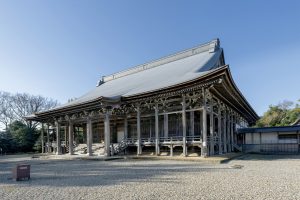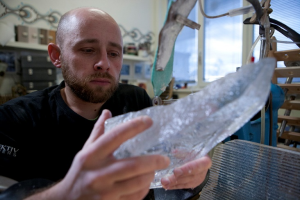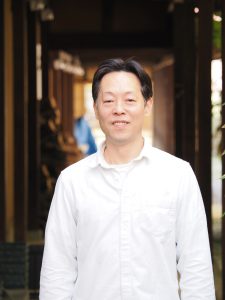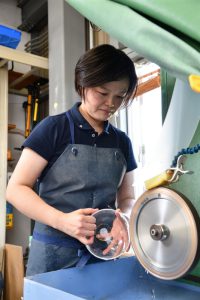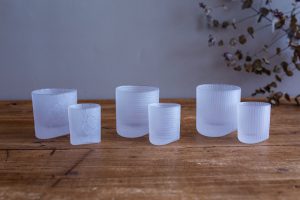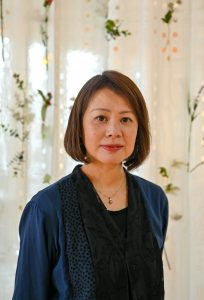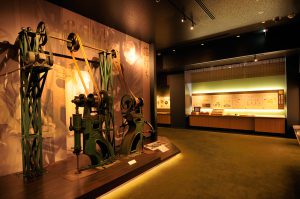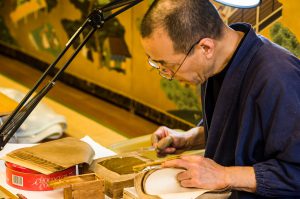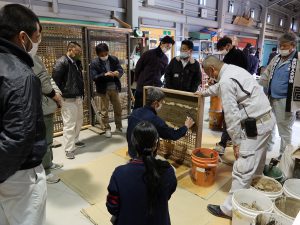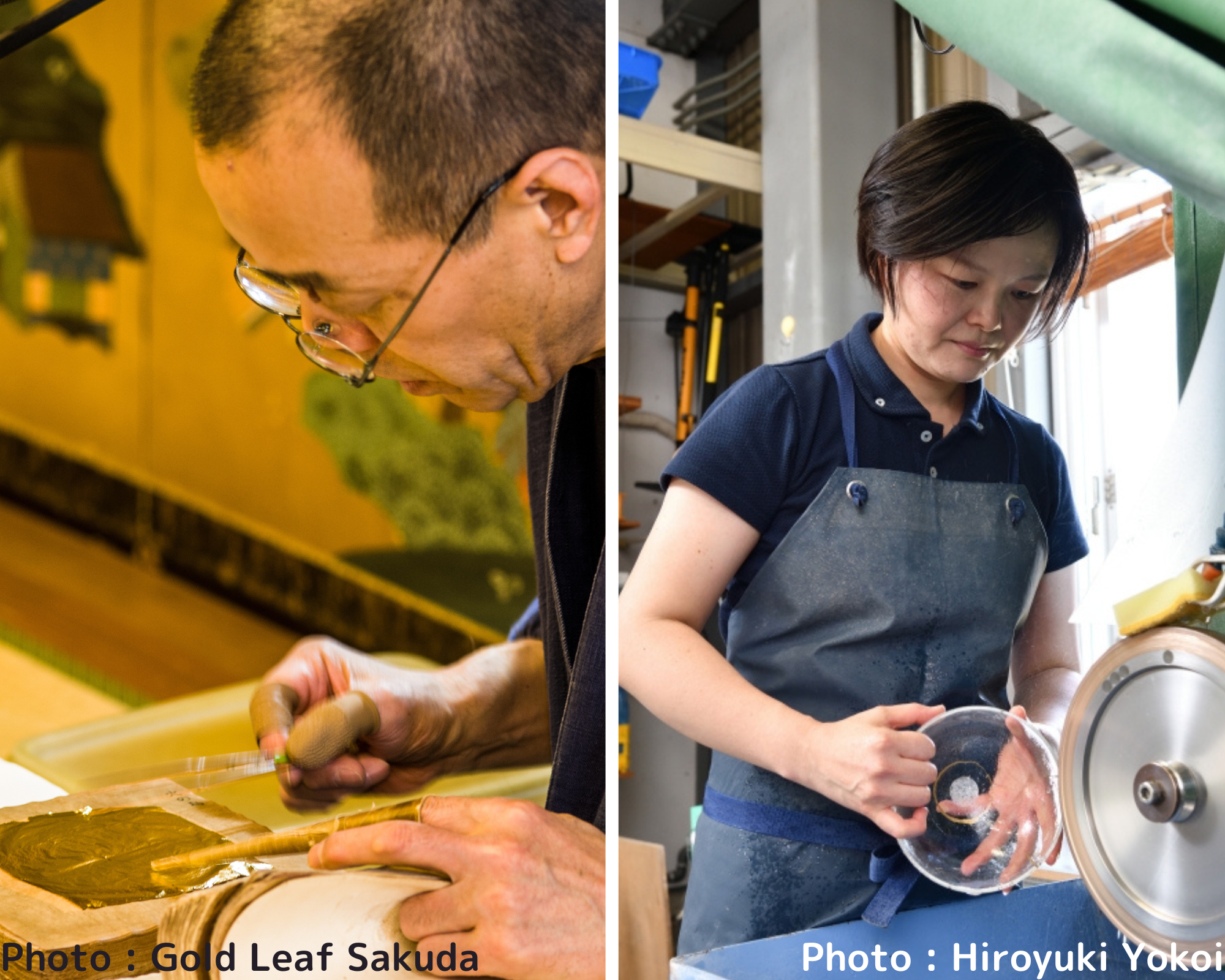
Toyama & Ishikawa Press Tour (Apr. 20-21)
2023.03.31
Surviving the Era of Population Decline With the Power of Art
Day 1: Toyama Prefecture
-Glass artisans attracting people to Glass City Toyama, and heading out into the wider world
-Miya-daiku, passing on traditional techniques to be used 100 years later
Day 2: Ishikawa Prefecture
-Manufacturing 99% of Japan’s gold leaf; people working to pass on gold leaf techniques and combine them with modern lifestyles
-The only school in Japan where professional artisans can learn advanced traditional techniques
-A new library where talking is allowed and visitors can try farming
In May 2023, Toyama Prefecture and Ishikawa Prefecture will jointly host the G7 Education Ministers’ Meeting, the first to be jointly hosted by two prefectures in Japan. The two prefectures were both part of the Kaga Domain in the Edo period (1603–1871), and the leaders of Kaga avoided conflict, using academics and culture to develop their domain. This tour will cover cultural artifacts and traditional crafts which were passed down thanks to this patronage, such as Shokoji Temple (designated a National Treasure in 2022) in Toyama and gold leaf techniques (added to the UNESCO list of Intangible Cultural Heritage in 2020) in Ishikawa.
Cultural artifacts and traditional crafts require advanced techniques to preserve and utilize them, but with changes to the lifestyle of Japanese people and the structure of society, finding people to pass on these techniques to has become an issue. In FY2021, the ratio of seniors (people aged 65 or over) in Japan was 28.9%, but in the same year it was 30.3% in Ishikawa and 33.1% in Toyama, as compared to major urban centers the issues of a declining birthrate and aging population have progressed further, and there is a shortage of young artisans.
In addition to traditional crafts, Toyama is also known for glass. In 1985, Toyama City began a Glass City Building project, with the intent to develop the city not through glasswork, but by training people involved in working with glass. The city has a long-standing connection with glass. In the Edo period, medicine sellers who would visit people in their homes to do business were known throughout Japan as “Toyama medicine sellers.” In the Meiji (1868–1912) and Taisho (1912–1926) periods, many glass bottles were manufactured for medicine, and so many glassworkers lived there.
This tour will visit facilities representing the two prefecture’s histories and traditions, and the culture developed based on them, to experience their appeal. The tour will also cover efforts to pass on techniques in the era of population decline, including examples of repairs made to cultural artifacts and educating new generations to pass on techniques, and initiatives to popularize traditional culture.
The tour will also look at how crafts in both prefectures have developed to meet the needs of the times, including fusions of traditional and modern crafts, considerations for foreign markets, and efforts for sustainability.
Day 1: Toyama Prefecture
-Glass artisans attracting people to Glass City Toyama, and heading out into the wider world
-Miya-daiku, passing on traditional techniques to be used 100 years later
1. Unryuzan Shokoji Temple
—Hiring Young Workers to Pass on Miya-daiku Techniques to Future Generations
Shokoji Temple was built in 1584 in Takaoka, in the northwest of Toyama Prefecture. Starting in 1998, it was repaired over 23 years, with the miya-daiku (carpenters specialized in shrines and temples) taking advantage of many building parts which were made in the Edo period. In order to maintain not only the beauty of historical buildings, but also use as many original parts as possible when repairing them, the miya-daiku consider repairs 100 years in the future as well when they are preserving and repairing buildings. This temple is a rare example in Japan of a temple that looks just as it did in the past.
Mr. Satoshi Funaki, 39, worked on those major repairs as a miya-daiku from the beginning, and for the last three years he was the head carpenter. In 2012, while those major repairs were still ongoing, looking to the future he decided to go independent at the age of 29 and established his own company, Funaki Kosho, which handles repairs for shrines and temples in the prefecture. In order to preserve traditional Japanese architecture for future generations, he is also putting effort into training four young employees in their 20s and 30s.
A curator will show the tour around the temple. Mr. Funaki will provide an explanation of the repairs and what they repaired, as well as demonstrating the joining methods used in repairing cultural properties without using fasteners such as screws, and shaping wood with a plane.
2. Toyama Institute of Glass Art
—The Only Public Glass Art Education Facility in Japan for Training Artisans Active at a Global Level
Established in 1991 as the first public specialized educational institution, the Toyama Institute of Glass Art encouraged international exchange from the beginning by bringing in professors from overseas, creating opportunities for Toyama glass to become known to people around the world.
The institute aims to train people from a variety of perspectives, including presentations where students discuss their works and their thoughts on making works of art.
Joined by a professor who has been with the institute since its establishment, the tour will speak with a teacher from Czechia who teaches glass working in Toyama, and a former architect from China who joined the institute as a student last year.
3. Toyama Glass Studio
—Systems to Support Artists, and Development of “Remelt Blue” by Recycling Waste Glass
It is said that two things are necessary to solve issues all glassworkers face: a place to make glassworks with a furnace to melt glass, and a sales route for the glassworks they make. Toyama Glass Studio was established to solve these issues and support young artisans. The studio also has a place where tourists and local elementary school students can experience glass working. Last summer, the studio also began a remelt initiative using waste glass, having noticed the amount of waste glass produced when making glassworks.
The tour will be shown the facility by Honorary Director Noda, and interview glassworkers who graduated from the Toyama Institute of Glass Art, used the Toyama Glass Studio, and now work independently in the prefecture.
4. Glassworkers Based Out of Toyama Prefecture
①The Internationally Recognized “Wizard of Lace Glass,” Mr. Taizo Yasuda
Mr. Yasuda was born in Kobe, Hyogo, but moved to Toyama at the age of 18 as part of the inaugural class of the Toyama Institute of Glass Art. He then gained experience at the Toyama Glass Studio, and at the age of 25 went independent and made his own workshop, Taizo Glass Studio, in a 140-year-old traditional wooden house, leaving its exterior as it was.
Mr. Yasuda’s works are known for incorporating lace glass, a well-known Venetian glass technique that creates lace-like patterns of white lines, and a Michelin star restaurant in Toyama use his products.
The tour will visit Mr. Yasuda’s studio, and hear from him about his thoughts on promoting Toyama’s glass culture and passing on techniques to the next generation.
②A True Toyama Native Glassworker, Ms. Rikie Shojiguchi
Ms. Shojiguchi helped with Toyama’s Glass City project to promote culture and create an environment where people could learn about glass working, and from there studied at the Toyama Institute of Glass Art and became a glassworker herself. Her glassworks are recognizable for their round shapes, based on her concept of “gentle, soft, and comfortable.”
At the Toyama Glass Studio, which Ms. Shojiguchi used to be a member of, she will speak about her thoughts towards her glassworks, and about the popularization of glass culture in Toyama.
Photo (left) : Hiroyuki Yokoi
5. Toyama Glass Art Museum in Toyama Kirari
—Holding One of the World’s Largest Glass Exhibitions
With exhibitions of mainly modern glass art, the Toyama Glass Art Museum is located in the center of Toyama City, as part of a multipurpose facility that includes a library and a bank. In addition to tourists, many locals also casually stop by the facility when out on the town, making it popular with a variety of people.
In recent years, the museum has been holding international exhibitions, and in its most recent international glass exhibition held in 2021, it had 1126 entries from 51 countries and regions around the world, making it one of the largest glass exhibitions in the world.
Guided by Mr. Tsuchida, the director of the museum and chair of ICOM Glass, the tour will hear about the features of the museum and its exhibits.
6. Bibibi and Jururi, Toyama Prefectural Museum of Art and Design (Lunch)
—Dishes and Ingredients All From Toyama
This restaurant serves food using seasonal flavors gathered from 15 municipalities around Toyama Prefecture. The dishes used to serve the food were also made by Toyama industries (such as aluminum, traditional copper, and glass).
Day 2: Ishikawa Prefecture
-Manufacturing 99% of Japan’s gold leaf; people working to pass on gold leaf techniques and combine them with modern lifestyles
-The only school in Japan where professional artisans can learn advanced traditional techniques
-A new library where talking is allowed and visitors can try farming
1. Traditional Gold Leaf Craftsmanship
—The History of a Traditional Method Registered as UNESCO Intangible Cultural Heritage, and Passing On Its Techniques
Kanazawa gold leaf has over 400 years of history, and has been used for decoration in everything from Buddhist temples and Shinto shrines to furniture, paintings, and handmade crafts. Today, 99% of Japan’s gold leaf is made in Kanazawa, and their traditional techniques to flatten gold out to 1/10,000th of a millimeter are what Kanazawa artisans are known for. There are two methods for making gold leaf, the modern method of cutting and the traditional method of enzuke, with over 400 years of history. Enzuke uses handmade washi (Japanese paper) to beat the gold, and was added to the UNESCO list of Intangible Cultural Heritage in 2020 as part of the “traditional skills, techniques and knowledge for the conservation and transmission of wooden architecture in Japan.”
①Yasue Gold Leaf Museum
Yasue Gold Leaf Museum is based on facility originally founded by Mr. Takaaki Yasue, a gold leaf artisan, and is the only gold leaf museum in Japan. The museum has exhibits of materials, tools, and pieces of art decorated with gold leaf to teach visitors about the history of gold leaf and its manufacturing process.
With the changes to people’s lifestyles and difficult economic factors, the demand for gold leaf has declined, and the number of traditional artisans dropped from 49 in 1998 to around one third, and is now around 15. Their average age is 70, and so passing on the traditional techniques in order to preserve them is an urgent issue.
At the museum, the City of Kanazawa is working together with partners including the World Monuments Fund, the Agency for Cultural Affairs, the Society for the Preservation of Traditional Kanazawa Gold Leaf, and Tiffany & Co. Japan Inc. on a public-private international cooperation project to train new artisans.
The museum’s director, Mr. Akitaka Kawakami, will show the tour around the museum, and explain the history of gold leaf and how it is made. There will also be an opportunity to interview one of the young trainees participating in the project to pass on gold leaf techniques.
Photo courtesy: Yasue Gold Leaf Museum
②Gold Leaf Sakuda
Gold Leaf Sakuda was established in 1919, and in the 1970s began making products using gold leaf. Today, while carrying on the tradition and history of gold leaf making, they are also working on new challenges, and in addition to working with glass, cloth, and copperware, they are involved in collaborations with traditional crafts throughout Japan.
Gold Leaf Sakuda president and chair of the Ishikawa Prefecture Commerce and Industry Co-op Mr. Kazunori Sakuda will speak about his company’ initiatives and plans for the future, as well as issues facing the industry. The tour will also be able to enter the workspace, where visitors are usually not allowed, and film and photograph work being down, as well as interviewing artisans.
Photo courtesy: Gold Leaf Sakuda
2. Kanazawa Shokunin Daigakko
—Advanced Traditional Techniques Being Passed On From Artisan to Artisan
Kanazawa Shokunin Daigakko (Kanazawa Artisan College) was established in Kanazawa in 1996. Until then, traditional architectural techniques in Japan were passed on locally, by individual masters training apprentices. This school is a training facility for artisans, with veteran artisans hired as lecturers to teach traditional architectural techniques to artisans with around ten years of experience. This is the only school in Japan which aims to teach advanced traditional techniques to students who already have experience as professional artisans. So far, 660 students have completed their training at the school, and they have worked on repairing cultural properties and traditional buildings throughout the prefecture and Japan.
The school’s president will speak with the tour about what led to the establishment of the school, its purpose and unique features, and its initiatives for passing on artisan’s techniques to the next generation and increasing public awareness.
The tour will also have the opportunity to interview the artisan teaching about critical elements of traditional Japanese architecture including sliding paper doors and tatami, and with students, as well as seeing hands-on practice being carried out.
3. Ishikawa Prefectural Library
—More Than Just Borrowing and Reading Books, A New “Hall of Knowledge” for Cultural Prefecture Ishikawa
Ishikawa Prefectural Library (also called the Hyakumangoku Bibliobaum) relocated to its current location in July 2022, due to the previous building both aging and running out of space. According to a study by the National Diet Library, only around 40% of people in Japan use a public library once a year or more. With the goal of overcoming this “40% wall” and attracting users to the library from throughout the prefecture, the new library has a variety of ways to have users try new reading experiences, based on the concept of “encountering books.”
In the library’s amphitheater-like main reading space, the collection is divided into twelve simple themes including “expanding your life,” “raising children,” and “thinking about work,” with unique efforts being made to make it easier for users to find books they want to read or to encounter books they had not even considered. Another unique feature of the library is that talking is generally welcomed. It also has unique facilities, such as playground-like equipment encouraging children to exercise, and a small field outside for users to experience farming. The library also has a learning space for meetings and remote work, an experiential space for handicrafts and food culture, Dan Dan Square where events can be held, and a cultural exchange area including a room for teaching. Ishikawa Prefectural Library has put effort into opportunities for multiple generations to increase their knowledge, beyond just borrowing and reading books.
The tour will see the library together with its director, Mr. Shunsaku Tamura (Keio University Professor Emeritus), who was involved with it since the earliest planning stages, and learn about the various unique features throughout the library.
【Tour Itinerary】
1.Dates:Thursday, April 20 to Friday, April 21, 2023
2.Schedule:
*The schedule is yet to be finalized, and may change without notice.
<Thursday, April 20>
7:20 ‐ 9:28 Tokyo Station- Toyama Station (Hokuriku Shinkansen Kagayaki 503)
10:25 ‐ 11:35 Unryuzan Shokoji Temple
12:25 ‐ 13:05 Lunch at Bibibi and Jururi, Toyama Prefectural Museum of Art and Design
13:25 ‐ 14:00 Taizo Glass Studio (Coverage of glassworker #1)
14:30 ‐ 15:00 Toyama Institute of Glass Art
15:05 ‐ 15:35 Toyama Glass Studio: Studio 2
15:40 ‐ 16:20 Toyama Glass Studio: Shop (Including covering glassworker #2)
16:40 ‐ 17:20 Toyama Glass Art Museum
17:30 ‐ 19:00 Dinner
19:15 Arrival at hotel
<Friday, April 21>
8:00 Leave hotel
8:31 ‐ 8:53 Toyama Station – Kanazawa Station (Hokuriku Shinkansen Tsurugi 709)
8:53 ‐ 9:20 Kanazawa Station
9:35 ‐ 11:00 Yasue Gold Leaf Museum
11:10 ‐ 12:10 Gold Leaf Sakuda
12:30 ‐ 13:30 Lunch
13:45 ‐ 14:55 Ishikawa Prefectural Library
15:10 ‐ 16:50 Kanazawa Shokunin Daigakko
17:00 Arrival at Kanazawa Station
17:57 ‐ 20:23 Kanazawa Station –Tokyo Station (Hokuriku Shinkansen Kagayaki 514)
3.Cost:15,000 yen per person, including transportation, accommodation (breakfast included), lunches (for both days) and dinner (for day 1).
* Cancellation fees will be informed after the participation is confirmed.
4.Participants:Limited to 10 applicants.
(Only one reporter or one photographer from each company, but two participants from each TV team will be acceptable.)
* If there are more applicants than positions available, the tour organizer may make arrangements.
5.How to apply:Please confirm the email.
6.Person in charge from the FPCJ: Ayako Sato
(Tel: 03-3501-5251、E-mail: sc@fpcjpn.or.jp)
7. Notes:
(1) This tour is sponsored by the G7 Education Ministers' Meeting Toyama Prefecture Committee and the G7 Education Ministers' Meeting in Toyama and Kanazawa Ishikawa Prefecture Promotion Council (“the Committees” below) and operated by JTB Corporation and JTB Communication Design, Inc., with planning assistance by the FPCJ.
(2) The schedule is subject to change without notice.
(3) This tour will require participants to bear a part of the cost, but is not a profit-making venture.
(4) Travel insurance will be provided by the organizers, but the Committees, JTB Corporation, JTB Communication Design, Inc. and the FPCJ take no responsibility for any accidents, injuries, illness, or other problems which occur during the tour.
(5) There may be some restrictions on photographing and filming at the tour sites. Please follow the instructions of the staff in charge.
(6) Please be aware that local government officials or members of the Japanese media may also be present, and film or photograph you as you are working.
(7) Please be aware that videos and photos of the tour, and articles about it, may be posted by the Committees or the FPCJ on their websites or social media.




